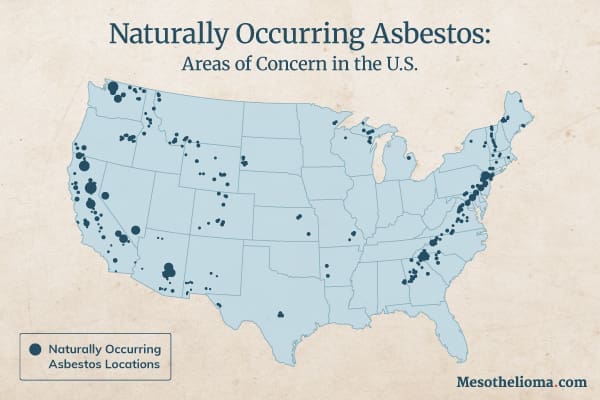
Asbestos is a mineral that was once widely used in construction and other industries. It occurs naturally in some U.S. soil and rock. When disturbed by digging, landslides and even wind, it can release microscopic fibers into the air that may cause serious diseases like mesothelioma.
Communities in places like California and Washington have faced this risk firsthand. If you live in an area with naturally occurring asbestos (NOA), it’s important to take proper precautions to limit exposure for yourself and your family. Here’s what to know about NOA, where it’s found and how to stay safe.
Where Naturally Occurring Asbestos Is Found in the United States
NOA is found in parts of the United States. It forms in certain types of rock and soil, especially in areas with a lot of geologic activity. Disturbing this soil, whether through construction or natural events, can release asbestos fibers into the air.
High-risk areas include:
- Appalachians and Rocky Mountains: Pockets of asbestos in natural rock formations
- Arizona and Nevada: Dry, rocky areas with exposed asbestos-containing soil
- California: Large deposits in foothill regions, including El Dorado Hills
- Washington: The Sumas Mountain area known for landslides that release asbestos
In places like these, even everyday weather can increase risk. It’s worth checking local or state health department websites for maps or updates if you live in or near these high-risk areas.
Recent NOA Examples in the United States
The following stories show how NOA can affect people even without industrial use or construction nearby. In these cases, the concern isn’t just about the activity that might disturb asbestos-containing material — as is common with asbestos in products or workplaces. Rather, the issue is that asbestos is already present in the environment.
When natural events like earthquakes or landslides disturb NOA, they can release asbestos fibers into the air, posing a health risk. Here are a few recent examples of NOA-related exposure in the United States:
- El Dorado Hills, California: In the early 2000s, the Environmental Protection Agency (EPA) found high levels of asbestos in the soil during a study of schoolyards and neighborhoods. Since then, the town has worked to reduce dust and limit exposure.
- Northern California: According to a 2004 report, some densely populated neighborhoods in Northern California are built on bedrock that contains asbestos. Wind and erosion in these areas can send asbestos fibers into the air.
- Sumas Mountain, Washington: A 2021 landslide released asbestos fibers that traveled through the valley and into nearby towns. Local health officials warned residents to be cautious during windy or dry weather.
How Naturally Occurring Asbestos Becomes Dangerous
Asbestos in the ground isn’t always harmful. The danger starts when the soil or rock gets disturbed. That’s when tiny asbestos fibers can break free and float in the air.
Common ways asbestos can get released into the air include:
- Construction and land development: Digging, blasting or grading land with NOA
- Natural disasters: Landslides, wildfires and earthquakes that shift soil
- Off-road activities: Dirt biking, hiking or all-terrain vehicle (ATV) riding on unpaved trails
- Road work and paving projects: Stirring up dust that contains asbestos
- Windy weather or erosion: Moving loose soil or dry dust into the air
If people breathe in those fibers, they can get trapped in the lungs and cause health problems years later.
Why It Matters
Once asbestos is in the air, it’s easy to breathe in without noticing. These fibers are too small to see and don’t cause symptoms right away. But over time, exposure can lead to:
The more often someone is exposed, the greater their risk may be. But even small amounts of exposure can be dangerous.
What to Do if You Live Near a NOA Site
Living near naturally occurring asbestos doesn’t necessarily mean you’re in danger all the time. But it does mean you may want to take some extra steps to lower your risk, especially during dry, windy weather or if nearby land is being disturbed. Even small changes, like using doormats, hosing down driveways or checking the weather, can help reduce exposure.
Here are 3 ways you can help keep yourself and your loved ones safe:
1: Limit Exposure at Home
- Keep your windows and doors closed on windy or dusty days.
- Remove shoes before going inside to avoid tracking in asbestos-containing dirt.
- Use HEPA filters in your heating and cooling system to trap tiny particles.
- Wet down driveways and bare soil around your home to keep dust from spreading.
2: Be Cautious Outdoors
- Avoid digging or disturbing soil unless absolutely necessary.
- Limit off-road activities like ATV riding or hiking in dry, dusty areas.
- Stay on paved roads and trails when walking, biking or driving.
3: Work With Your Community
- Ask about dust control for road work or construction near your home.
- Check with local or state health departments to find out if your area has NOA. The EPA’s website lists asbestos contacts by state.
- Get involved in community planning to advocate for safer practices in high-risk areas.
What to Do if You Think You’ve Been Exposed
Not everyone who’s been around naturally occurring asbestos will get sick. But if you’ve breathed in dust from disturbed soil or lived in a high-risk area for a long time, it’s a good idea to take action. Paying attention now can help reduce health problems in the future.
If you’ve spent time in a high-risk area or around disturbed soil, talk to your doctor. Describe your exposure and ask if you should see a specialist. Watch for symptoms like a persistent cough or chest pain. Some people may qualify for a free screening, financial help or legal support, especially if their exposure was linked to nearby construction or known NOA zones.
Stay Informed, Stay Safe
Naturally occurring asbestos can be a hidden hazard, but small actions can make a big difference. By learning where it’s found, reducing dust around your home and speaking with a doctor, you can help reduce the risk to both your health and your community.




